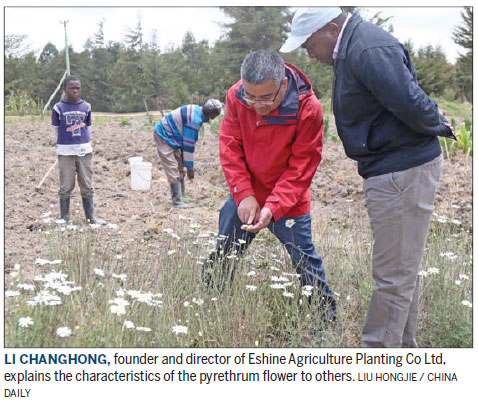Organic trend grows demand for crop

Chinese investor finds opportunity in the blossoming of Kenya's revived pyrethrum sector
Production of a valuable flower crop is blooming again in Kenya after years of wilting sales.
Chrysanthemums, aside from being attractive, are prized as a source of organic pesticides, called pyrethrum, which are increasingly in demand as the world shuns synthetic agricultural chemicals.

After years of slow sales, Kenyan farmers are enthusiastically looking forward to re-entering the booming global pyrethrum market. The sector, which once ranked highly among Kenya's cash crops, has in recent past nosedived, leaving thousands of farmers in financial ruin.
But the tide is slowly changing after a strong government initiative to revive the sector. New regulations have liberalized the once closed market and spurred the interest of private players such as Li Changhong, who plans to export to China.
The 41-year-old director and founder of Eshine Agriculture Planting Co Ltd hails from Hubei province in Central China. He is a licensed producer and processor of pyrethrum, which means he can grow, buy mature and dried flowers from farmers in a given region and export them. He has invested about $3.3 million in the venture.
He is among other players who are jostling for market position in the lucrative market that has experienced hard times over the past decade. According to the Pyrethrum Growers Association of Kenya, a farmers' lobby group, Kenya's production sharply declined from 10,000 metric tons in 2003 to 250 tons in 2011, triggered by a market glut of synthetic versions of pyrethrins. In addition, mismanagement in the Pyrethrum Board of Kenya and outdated regulations saw farmers receive no payments for their deliveries. Currently, some 20,000 farmers are owed $520,000, according to the board.
It is in this landscape that Li is operating. The uptake by farmers to plant the crop is slow, since only 30,000 farmers are growing the flower compared with more than 220,000 in the '90s. To instill confidence, the Chinese entrepreneur is buying and distributing farm essentials such as seeds. His firm has so far distributed about 3,000 packets to more than 4,000 farmers who have inked contractual deals to deliver sun-dried flowers to his company. He promises to pay $1.4 for every kilogram delivered, depending on the quality.
On a gloomy Wednesday at the end of August, Li meets with around 30 farmers in Koinange village, Nyandarua county in the Rift Valley. This is about one and a half hours' drive from downtown Nairobi and the county is among 12 that previously depended on the crop. Heavy clouds hang menacingly over the sky as his field operation officer, Zipporah Mugo, demonstrates how to transplant four-week green shoots from nurseries to the vast farms.
She instructs that the seedlings must be spaced 30 centimeters by 60 cm to give room for the plant to spread and bloom in six weeks.
"We are doing this all over again because many farmers have scant knowledge of how to maximize yields from this plant. Crowding reduces productivity," says Mugo, who has worked in the sector for more than a decade.
She advises the farmers to use fork-jembe tools to weed while warning them against applying pesticides. Mugo explains that inadequate funding has previously denied farmers extension services as money from the government goes into clearing previous debts. But Li is investing in these services to ensure the farmers and his company benefit from both quality and quantity. On maturity, farmers pluck flowers every two weeks. An acre can produce 70 kg of dried flowers.
But this is not only a demonstration exercise but also meant to build farmers' confidence in him. "From experience the farmers are wary. Shrewd, unlicensed brokers are also lurking in the sector, promising to buy the flowers at better prices but eventually never show up," says Li.
Samson Ndia Mueni, one of the farmers, recalls with nostalgia the days when the crop was their mainstay. It not only enabled him to feed and school his children but also fund his acquisition of more farming land. After the decline of the market, he turned to dairy and subsistence farming.
"But maize and potatoes are not flourishing in the low temperatures and heavy rainfall. We are therefore eager to return to pyrethrum farming," Mueni says.
lucymorangi@chinadaily.com.cn
(China Daily European Weekly 09/16/2016 page29)
Today's Top News
- One planet, all species living in harmony
- Xi stresses heritage protection
- New deal with ASEAN to lift free trade
- WHO adopts historic pact on pandemic
- Washington condemned over curbs on Chinese chips
- Engagements between China, US foster healthy relationship






























